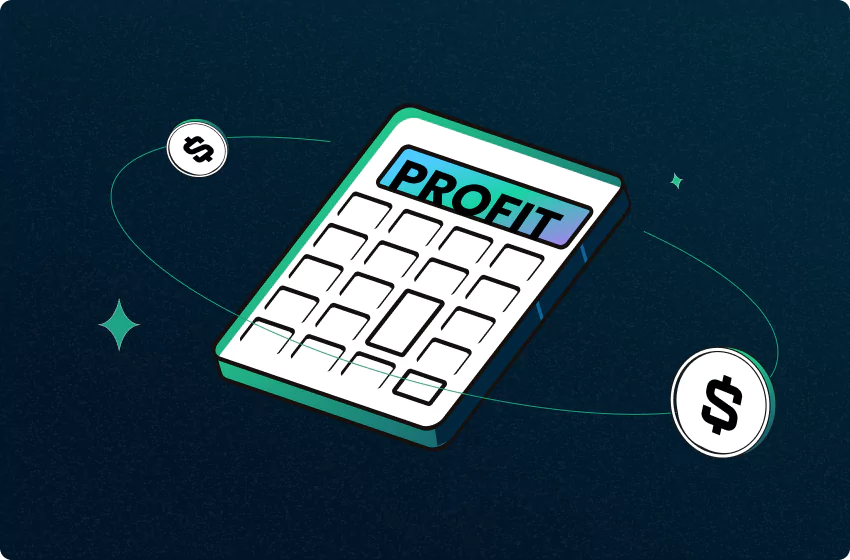How to Calculate Profit Margin for Dropshipping Business?

Selling online is easier than ever, thanks to platforms like Shopify. But one challenge remains: how to calculate profit margin for dropshipping accurately.
Revenue is easy to track, but it doesn’t reflect your true profitability. Ignoring profit margins can mislead your business decisions. The problem? Shopify doesn’t calculate profit automatically, as it depends on fluctuating costs like shipping, transaction fees, and ad spend.
So, how do you calculate profit margin for dropshipping? Whether manually or with automated tools, here’s the simplest way to get a clear view of your store’s profitability.
The Dropshipping Profit Margin Formula
Before diving into detailed breakdowns, let’s start with the fundamental formula for calculating profit margin:
Let’s say you run a dropshipping store on Shopify and generate $1,000,000 in sales in a year. Your total costs (including product costs, shipping, ads, payment processing fees, and other expenses) amount to $700,000.
So, your Shopify profit margin is 30%.
Now, let’s break down the key cost factors that impact your dropshipping profit.
The Key Cost Factors That Impact Your Dropshipping Profit
Many store owners miscalculate their costs, leading to inaccurate profit margins. But not you!
1/ Revenue is The First Step in Tracking Profit & Loss
Revenue is the total money you receive from customers—also known as total sales.
Important Note: Taxes and shipping fees charged to customers are included in revenue, but they don’t count as profit.
Shopify displays revenue prominently on its dashboard, making it easy to track. But without factoring in costs, revenue alone doesn’t tell you how much you’re actually making.
2/ Costs is The Most Important Factor in Profit Calculation
To calculate profit accurately, you need to account for all costs associated with running your store. These include:
Cost of Goods Sold (COGS) & Shipping Costs
Tracking COGS manually is challenging due to price fluctuations and shipping variations.
Manual Calculation Methods:
- AliExpress Orders – Unfortunately, AliExpress doesn’t allow you to export past orders, meaning you’ll have to manually add up product costs. This is fine for beginners but becomes time-consuming and error-prone as your store scales.
- Shopify’s COGS Field – Shopify lets you enter product costs manually, but this method has two major drawbacks:
- It doesn’t account for price fluctuations from AliExpress suppliers.
- It doesn’t include shipping costs, which can vary significantly.
- Bank Statement Method – Export an Excel file of all AliExpress payments from your bank or credit card statement, then sum them up. However, this makes it difficult to separate product costs from shipping costs unless you use a dedicated card for your store.
Automated Calculation Method:
A better alternative is using Shopify profit tracker apps that sync real-time COGS and shipping costs. However, many apps lack accurate syncing capabilities. Later, we’ll discuss TrueProfit, which automates this entire process.
Advertising Costs (Ad Spend)
Most dropshippers rely on Facebook Ads and Google Ads to drive sales. Advertising expenses can fluctuate, making them a crucial factor in calculating profit.
Here's how you can track your ad spend:
- Facebook Ads Manager & Google Ads Dashboard – Check your ad spend daily, weekly, or monthly.
- Shopify Reports – Some Shopify plans provide insights into ad spend.
Payment Processing Fees
Every payment gateway charges a fee, which reduces your net profit.
Common Payment Processing Fees:
- Stripe & PayPal: 2.9% + $0.30 per transaction
- Shopify Payments: Similar to Stripe, but Shopify charges an extra fee (0.5% - 2%) if you use third-party processors.
To track these fees, check the Reports Section of your payment provider.
Other Expenses (Custom Spend)
Additional costs impacting your profit include:
- Shopify Plan Fees
- Apps & Software
- Influencer & Affiliate Payments
- Taxes & Accounting Fees
You need to take all of these costs into account while calculating your dropshipping profit margin.
Or, you can use a much better alternative.
Calculate Your Dropshipping Profit Margin Automatically with TrueProfit
Instead of manually tracking costs, TrueProfit does it for you. It automatically pulls real-time data from:
- Shopify – Revenue, refunds, and discounts
- AliExpress, CJDropshipping – COGS & shipping costs
- Ad platforms like Facebook, Google, TikTok– Ad spend
- Payment Gateways – Processing fees
With TrueProfit, you get a real-time dashboard showing:
- Net Profit
- COGS & Shipping Costs
- Processing Fees
- Conversion Rates
- Profit Margins
Instead of asking, "How do I calculate dropshipping profit?", shift your focus to: "How do I maximize my profit?"
Final Thoughts
Manually tracking your dropshipping profit is doable—but it’s time-consuming, prone to errors, and difficult to scale. You don’t want to spend hours pulling numbers from different platforms when you could be focusing on growing your business.
This is why you need a profit tracking app like TrueProfit. Instead of juggling spreadsheets and manual calculations, you get real-time profit insights automatically pulled from Shopify, AliExpress, Facebook Ads, and more.
- See your actual profit in real time
- Track all expenses, including COGS, shipping, and ad spend
- Make data-driven decisions to scale your business
Why calculate profit manually when you can have it done for you? Try TrueProfit today and shift your focus from calculating profits to maximizing them!
Irene Le is the Content Manager at TrueProfit, specializing in crafting insightful, data-driven content to help eCommerce merchants scale profitably. With over 5 years of experience in content creation and growth strategy for the eCommerce industry, she is dedicated to producing high-value, actionable content that empowers merchants to make informed financial decisions.





 Shopify profits
Shopify profits